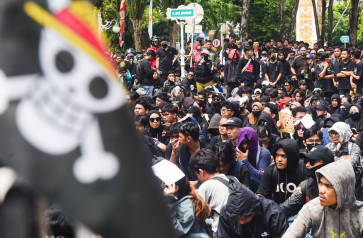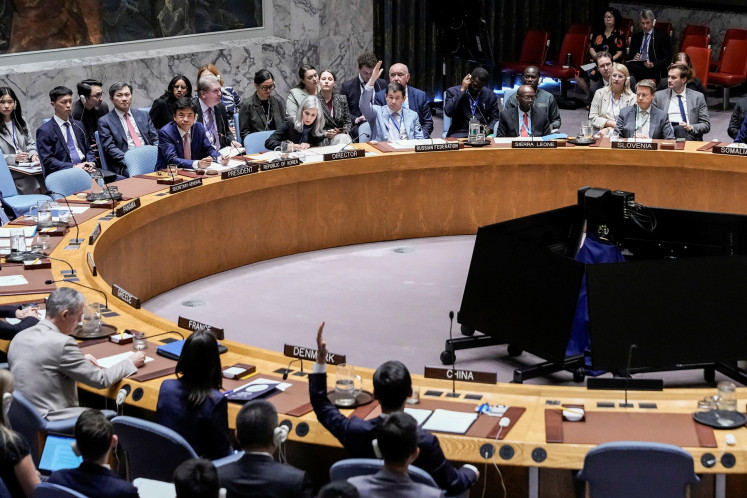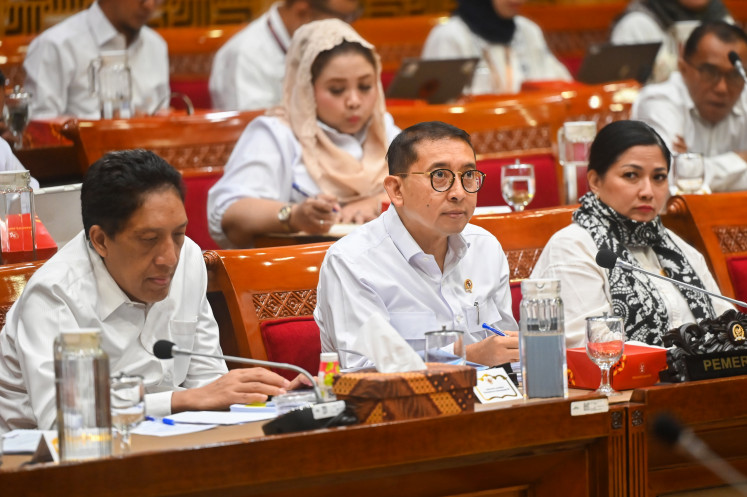Popular Reads
Top Results
Can't find what you're looking for?
View all search resultsPopular Reads
Top Results
Can't find what you're looking for?
View all search resultsGovt estimates lower subsidy amid global decline in gas price
The government expects to spend less on this year’s subsidy for 3-kilogram canisters of liquefied petroleum gas (LPG) amid the declining trend in the global gas price
Change text size
Gift Premium Articles
to Anyone
T
he government expects to spend less on this year’s subsidy for 3-kilogram canisters of liquefied petroleum gas (LPG) amid the declining trend in the global gas price.
Energy and Mineral Resources Minister Ignasius Jonan said on Monday during a House of Representatives hearing that the price of CP Aramco — the global benchmark for LPG — had fallen 40 percent since October 2018.
“Last October, CP Aramco was US$655 per ton, but now it is $375 per ton, or down $280. This is half the price. At the recent Cabinet meeting, we were still undecided whether to make a price adjustment or not,” he said.
Assuming that the gas price continued to hover around $375 until December, the ministry estimated it would spend Rp 44.16 trillion ($3.16 billion) on the subsidy for 3 kg LPG canisters, about half the Rp 75.22 trillion budgeted for this year.
Government spending on the 3 kg LPG subsidy reached Rp 19.2 trillion in May for 2.8 million metric tons (MT) of gas, or 40 percent of the 2019 subsidy allocated for 6.9 million MT of gas.
“Our 2019 subsidy is safe,” said Jonan, indicating that spending would not exceed the budget. “Now, the question is whether the pricing formula for our subsidized LPG is still relevant or not,” he added.
The energy ministry revised the LPG pricing formula in April with the issuance of Ministerial Decree No. 61/2019 on the ceiling price for subsidized 3 kg LPG canisters. The new formula uses a certain percentage of the market reference price (HIP) — which is based on CP Aramco — and the gas production cost.
The previous pricing formula used the cost per metric ton, calculated at $50.11, and the fixed production cost, set at Rp 1,879 per kg.
Using the new formula, the market price of LPG is Rp 29,400 for each 3 kg canister. At a ceiling price of Rp 18,000, the subsidy is Rp 11,400 per 3 kg canister, or 3,800 per kg of gas.
The final price is subject to review if the government deems it inaccurate.
Nicke Widyawati, president director of state energy holding company Pertamina, assured that the declining trend in the global gas price would not affect the distribution of the subsidized 3 kg LPG canisters.
“Even if the subsidy is lowered, the distribution of subsidized LPG will not be affected, since the volume remains the same,” she said on Monday after the House hearing.
Her statement corresponds with the ministry’s gas distribution estimate of 6.85 million MT, or 2 percent lower than the subsidized gas distribution of 6.97 million MT allocated in the state budget.
Separately, the ministry’s oil and gas director general, Djoko Siswanto, said that the lower subsidy would not affect the retail price of subsidized 3 kg LPG canisters, which currently stood at Rp 4,250 per kg.
“In other words, the [global] situation has saved our subsidy allocation Rp 30 trillion,” he said.
Even though the ministry had estimated lower subsidy spending until the end of the year, Jonan said that he would not revise the subsidized gas distribution of 7 million MT it had recommended for next year.
However, he asked that the House Commission VII overseeing energy to review the ministry’s plan to switch from the current “open” (indirect) to a “closed” (direct) subsidized gas distribution scheme next year in consideration of the declining global gas price, which would ease the subsidy burden.
Under the “open distribution” scheme, the subsidy is given to Pertamina, the primary LPG distributor, which then sells the 3 kg canisters of gas below the market price.
However, the scheme has been prone to misuse by those ineligible for the subsidized gas, such as restaurants, which had bloated the subsidy budget in recent years. The intended recipients of the subsidized gas are poor families.
The ministry thus came up with its plan to introduce the “closed distribution” scheme next year, which would distribute the subsidized gas directly to eligible recipients through the “poor card” or barcode systems.
“The fact is, the price [of gas] has been declining since last October,” said Jonan. He added that the current condition presented an opportunity to evaluate “whether the LPG price should stay the same or not, and whether to adopt a closed distribution scheme or not”, indicating that the lower global gas price meant that the government could continue with its “open distribution” scheme
“The closed distribution scheme might be perfect for recipients with fixed addresses, but it will cut the supply for [itinerant] street vendors,” he said.
House Commission VII legislator Fadel Muhammad of the Golkar Party faction said that the House had developed the idea for a closed distribution scheme in line with the government’s plan to introduce the “poor cards”, both of which aimed to improve subsidy allocation.
However, said Fadel, the declining trend in the global gas price was a reason to rediscuss the closed distribution plan.
“We should make a decision on whether to use the ‘closed’ or ‘open’ [distribution] subsidy scheme before the 2019 [budget year] ends,” he said during the hearing.










